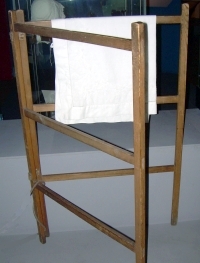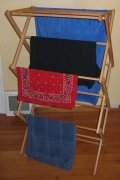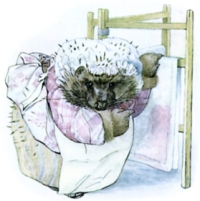-
History of:
- Resources about:
- More:
- Baby walkers
- Bakehouses
- Bed warmers
- Beer, ale mullers
- Besoms, broom-making
- Box, cabinet, and press beds
- Butter crocks, coolers
- Candle snuffers, tallow
- Clothes horses, airers
- Cooking on a peat fire
- Drying grounds
- Enamel cookware
- Fireplaces
- Irons for frills & ruffles
- Knitting sheaths, belts
- Laundry starch
- Log cabin beds
- Lye and chamber-lye
- Mangles
- Marseilles quilts
- Medieval beds
- Rag rugs
- Rushlights, dips & nips
- Straw mattresses
- Sugar cutters - nips & tongs
- Tablecloths
- Tinderboxes
- Washing bats and beetles
- Washing dollies
- List of all articles
Subscribe to RSS feed or get email updates.
Articles to be provided for Ironing
...There should be, at least, three irons for each person ironing, and a small and large clothes-frame, on which to air the fine and coarse clothes.
Catherine E. Beecher, Treatise on Domestic Economy, 1856
...For should the skies pour down, adieu to all
Remains of quiet; then expect to hear
Of sad disasters – dirt and gravel stains
Hard to efface, and loaded lines at once
Snapped short – and linen-horse by dog thrown down,
And all the petty miseries of life.
Saints have been calm while stretched upon the rack,
And Guatimozin smil'd on burning coals;
But never yet did housewife notable
Greet with a smile a rainy washing-day.
Anna Lætitia Barbauld, Washing-Day, 1797
We keep no horse, but a clothes-horse; enjoy no saddle so much as a saddle of mutton.....
Charles Dickens, Sketches by Boz, 1836
Indoor hedges in winter?
Clothes horses, airers, maidens, winter hedges
>>>>or go direct to drying outside
 A winter hedge was a handy place to dry your laundry when you couldn't put it outside,
though not as good as the hedges and bushes outdoors in summer. Then your washing
would dry in the fresh air while the sun bleached it.
A winter hedge was a handy place to dry your laundry when you couldn't put it outside,
though not as good as the hedges and bushes outdoors in summer. Then your washing
would dry in the fresh air while the sun bleached it.
As the name for a frame to spread your wet washing on indoors - in front of the fire in a small cottage, or in the laundry room of a large house - winter hedge was once common in northern England.
Elsewhere it was a clothes horse. That may sound like an interesting image, but horse just meant a stand or frame supporting something - think saw-horse. Wherever they were, and even when they were called airers or drying racks, they were simple barred frames like gates hinged together with canvas or leather or string.
 Searching
for "traditional clothes horse" on the net shows an upright wooden concertina, (left),
surely needing quite advanced carpentry skills. An older tradition was for
clothes airers like the one above, or
Mrs. Tiggy-winkle's (below right). Simple sets of 2 or 3 frames that wouldn't
be hard to make, they were often described as 2- or 3-leaf clothes horses.
Searching
for "traditional clothes horse" on the net shows an upright wooden concertina, (left),
surely needing quite advanced carpentry skills. An older tradition was for
clothes airers like the one above, or
Mrs. Tiggy-winkle's (below right). Simple sets of 2 or 3 frames that wouldn't
be hard to make, they were often described as 2- or 3-leaf clothes horses.
 Although there's a market for a lot of old domestic paraphernalia, clothes horses
seem to be an exception. Perhaps the wood was recycled or burnt?
Although there's a market for a lot of old domestic paraphernalia, clothes horses
seem to be an exception. Perhaps the wood was recycled or burnt?
They were also called maiden or maid, a name once shared with other women's tools like washing dollies and parts of spinning wheels. Some people say the word maiden meaning clothes rack is disappearing, used "only" in dialect (see the Oxford English Dictionary), and yet plenty of people in northern England say 'maiden' for clothes airer while speaking quite standard English. You sometimes see it in print and, of course, on the net.
Polished clothes horses from the cabinet-maker
They were also called clothes frames or screens -sometimes actually used for impromptu screening, like one in a 19th C tavern bedroom. (See boxed quote right.) It was probably a "chamber clothes horse": polished bedroom furniture. Both folding and non-folding are listed in 18th century cabinet-makers' price books: in New York in 1796, and in London three years earlier, where an extra leaf would cost one shilling and sixpence. Antique furniture dealers don't seem well-stocked with these. Did they go for firewood too?
As there was apparently no other guest that night in the tavern, I had my choice of the beds, and I selected one in a snug corner behind the door, across the foot of which I made a screen with my clothes, on a winter dykes [Scottish clothes horse], so that I was in a sense almost as much apart from the general commonage of the chamber, as if I had been in a separate room.
John Galt, Lawrie Todd, 1830
Children used them to make houses, if they were allowed to, but not on washing day, nor on ironing day, when they were needed to air pressed linen before it was folded away. When traditional fabrics were starched and pressed with flat irons, clothes were ironed very damp.
Alternative styles of early 19th century clothes frames are illustrated here, with designs from Holland and Tuscany.
Other names include winter dykes, or claes (clothes) dykes in Scotland, where dyke means a wall, and linen-horse. Names varied regionally within England, with winter hedge surviving well in Yorkshire. Clothes frame seems to be particularly American, but my dictionary doesn't throw any light on that.
You may also like an article on indoor drying racks hanging from the ceiling or one about drying socks on sock stretchers aka stocking airers.
 26 May 2007
26 May 2007
Drying outdoors
Drying the washing in sunshine was, among other things, an effective way of bleaching linen and keeping it white. It was an essential part of the laundry process even when weeks of wet weather meant indoor drying on free-standing clothes horses or ceiling racks on pulleys must substitute for a while.
Spreading laundry on grass, bushes or washing lines out of doors meant there was a risk of having it stolen. Thieves of white clothes and household linen were sometimes called "snow gatherers".
...off she went, carrying the basket on her head, and hung her clothes carefully out, the big things on lines between the fruit trees, and the little things, such as stockings and pocket-handkerchiefs, stuck on the gooseberry bushes, or spread upon the clean green grass. "Such a fine day as it is! they'll dry directly," said she cheerfully to herself. "Plenty of sun, and not a breath of wind to blow them about. I'll leave them for an hour or two, and come and fetch them in before it grows dark. Then I shall get all my folding done by bed-time, and have a clear day for ironing to-morrow."
Dinah Craik, The Adventures of a Brownie as Told to My Child, 1872
Well-to-do 17th century households were advised that box or privet (primp) hedges were good for drying. They could be clipped to have a "smooth and level" surface.
...a border of Primpe, Boxe, Lauandar, Rose-mary, or such like, but Primpe or Boxe is the best, and it was set thicke, at least eightéene inches broad at the bottome & being kept with cliping both smooth and leuell on the toppe and on each side, those borders as they were ornaments so were they also very profitable to the huswife for the drying of linnen cloaths, yarne, and such like: for the nature of Boxe and Primpe being to grow like a hedge, strong and thicke, together, the Gardiner, with his sheares, may kéepe it as broad & plaine as himselfe listeth.
Gervase Markham, The English Husbandman, 1613
For more on old laundry methods see:
History of Laundry: washing and drying
List of all laundry articles on this site
History of Ironing
You may like our new sister site Home Things Past where you'll find articles about antiques, vintage kitchen stuff, crafts, and other things to do with home life in the past. There's space for comments and discussion too. Please do take a look and add your thoughts. (Comments don't appear instantly.)
For sources please refer to the books page, and/or the excerpts quoted on the pages of this website, and note that many links lead to museum sites. Feel free to ask if you're looking for a specific reference - feedback is always welcome anyway. Unfortunately, it's not possible to help you with queries about prices or valuation.


